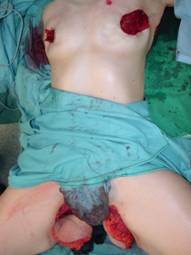McCormick Place, Lakeside Center
Sunday, September 25, 2005
9:00 AM - 5:00 PM
McCormick Place, Lakeside Center
Monday, September 26, 2005
9:00 AM - 5:00 PM
McCormick Place, Lakeside Center
Tuesday, September 27, 2005
9:00 AM - 5:00 PM
McCormick Place, Lakeside Center
Wednesday, September 28, 2005
9:00 AM - 5:00 PM
8711
The Extended Indications For The TMG-Flap In Breast Reconstruction
Introduction: The Transverse myocutaneous gracilis (TMG)-flap was first described by Yousif NJ and further popularized for breast reconstruction by the two authors. With the gaining experience the indications for a TMG-flap breast reconstruction extended continuously. At the beginning we thought that only the small to moderate sized breast should be reconstructed with a TMG-flap. But using two flaps for one breast allows also to reconstruct even larger breasts with an aesthetical pleasing donor site. The incision lines and the donor-site morbidity is similar to a classic medial thigh lift. Material and Method: From 01/2002 to 02/2005 the flap was used in four patients for augmentation, in 38 patients after unilateral skin sparing mastectomy, in 6 patients after bilateral skin sparing mastectomy, in 6 patients a bilateral TMG-flap plasty was used for one breast. The TMG-flap was used in three patients for a secondary reconstruction and two times for correction of a contour deformity after breast conserving therapy. In three patients with polands' syndrome the flap was used to replace the missing pectoral muscle and to add volume to the hypoplastic breast.
Results: We have lost two flaps from 58 which were replaced by a prosthesis. In no single case we have encountered a perfusion problem with the skin island or a tip necrosis. In for cases a scar revision was done to improve the donor site. Six patients had small areas of ischaemic skin necrosis related to very thin preparation of the mastectomy skin envelope without altering the final good aesthetic results. There was no functional donor-site morbidity caused by harvesting the gracilis flap and a very inconspicuous donor site scar was always encountered. In the long term follow up(more than 2 years) patients ( n=12) no volume reduction due to anticipated muscle atrophy was noticed.
Summary: The TMG-flap is a valuable alternative for immediate autologous breast reconstruction after skin-sparing mastectomy and in selected patients for secondary reconstruction. It has become the first choice option in our hands for reconstructions of small to moderate breasts even before tissue sources from the lower abdomen or the gluteal region. We are convinced that this method will win recognition in the following years for it's simple technique compared to the demanding perforator surgery and the most pleasing donor site and we strongly encourage all microsurgeons to use the TMG-flap as a powerful alternative in breast reconstruction.
 |  | ||
Bilateral TMG-flap skin sparing breast reconstruction
View Synopsis (.doc format, 76.0 kb)
